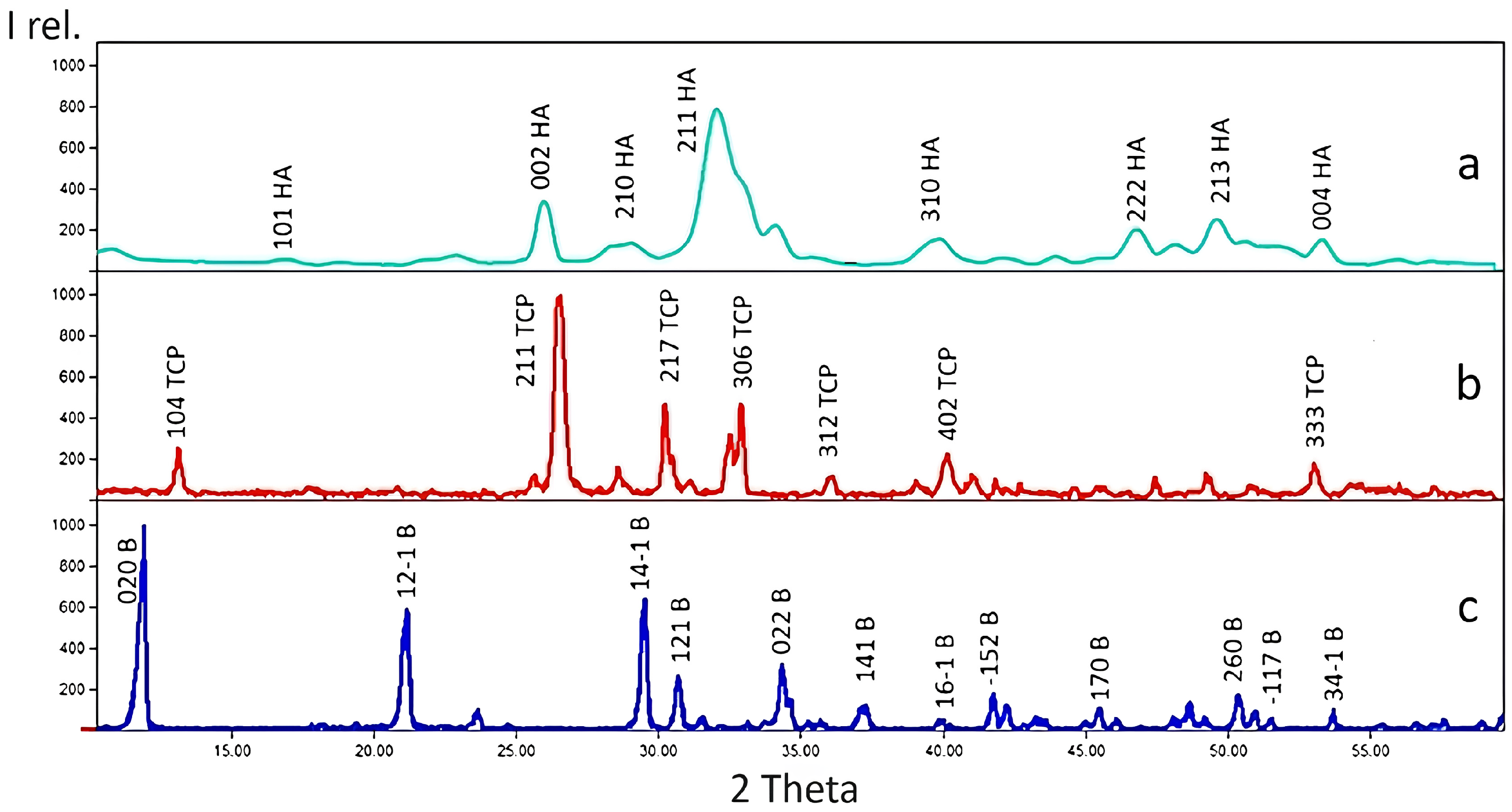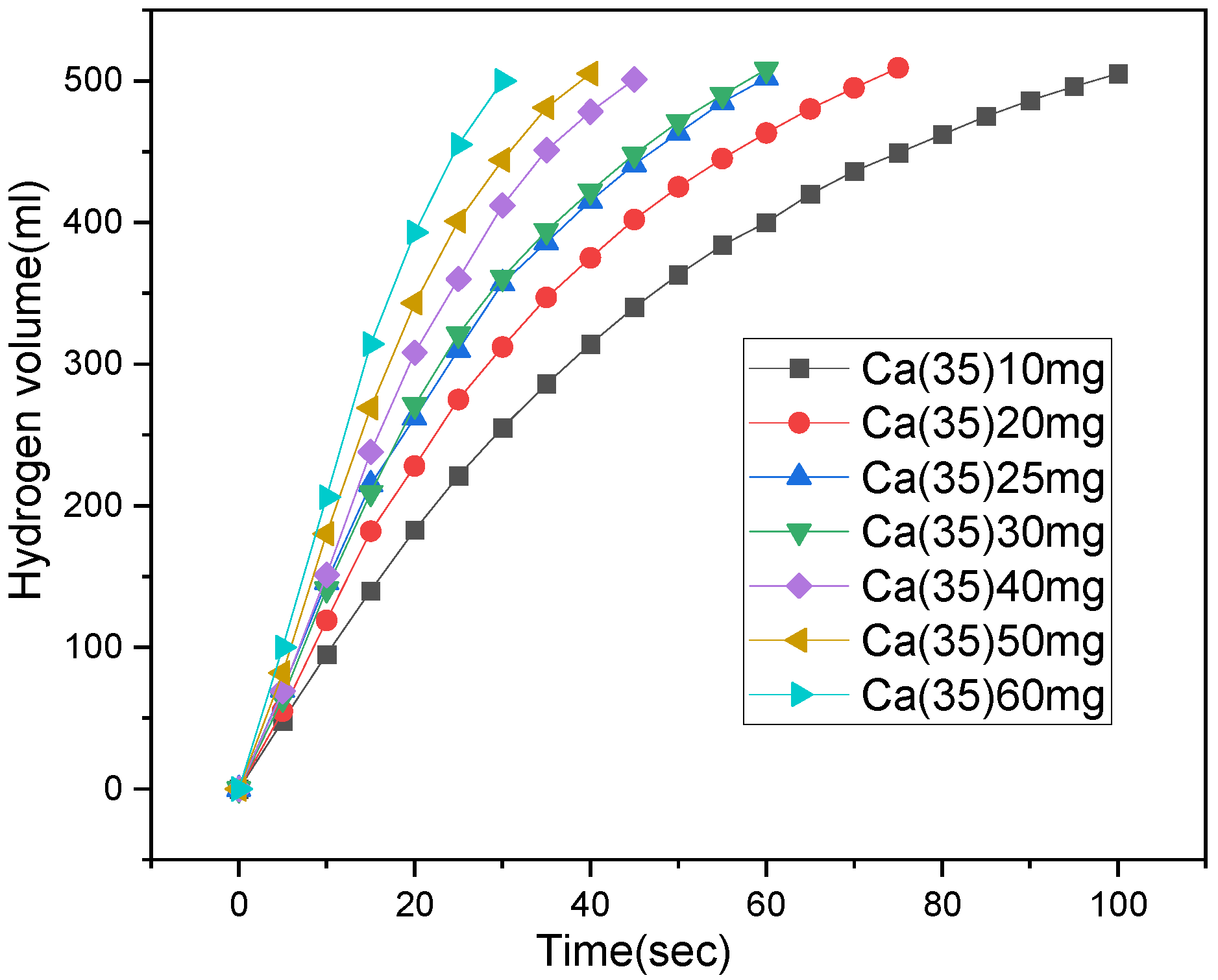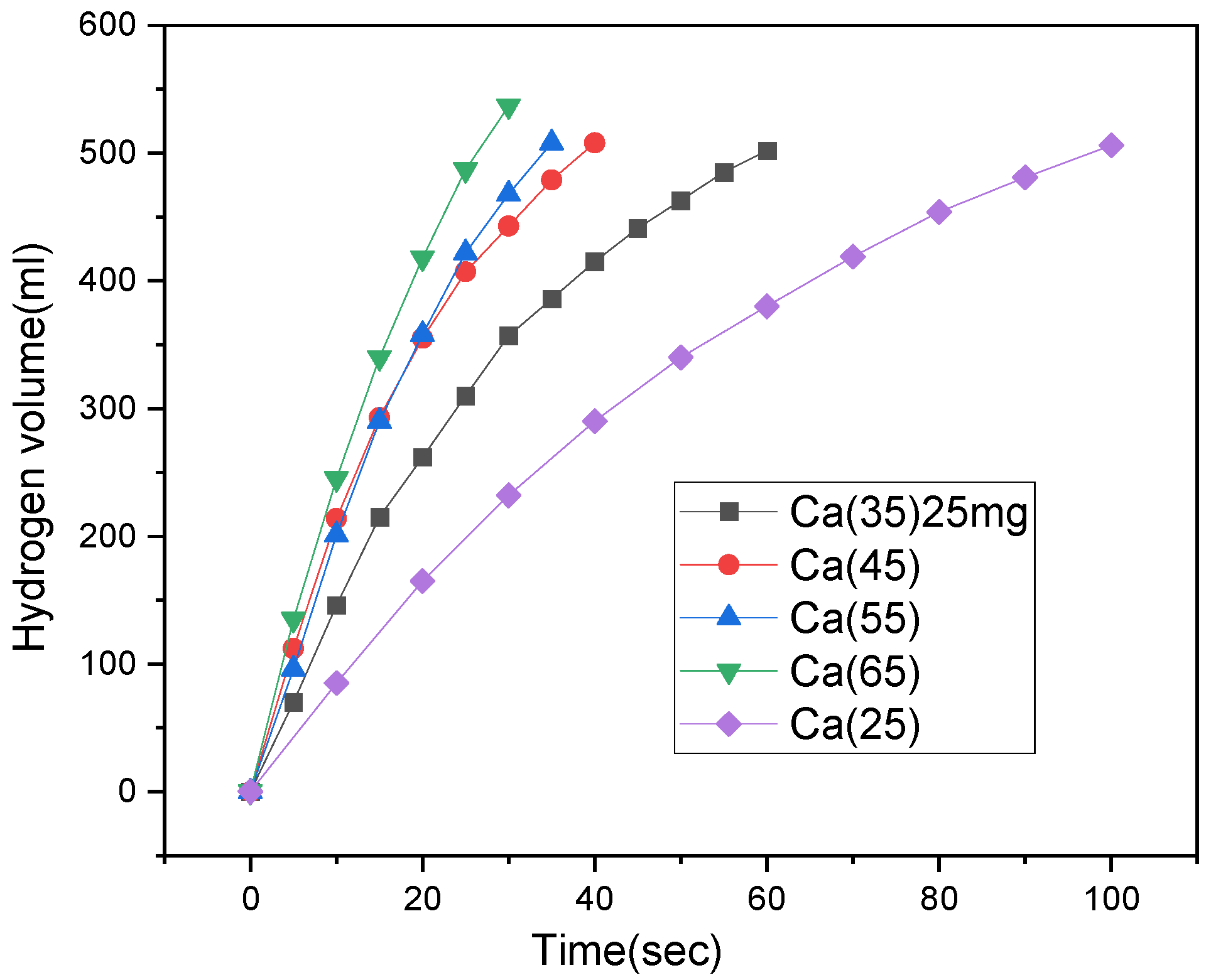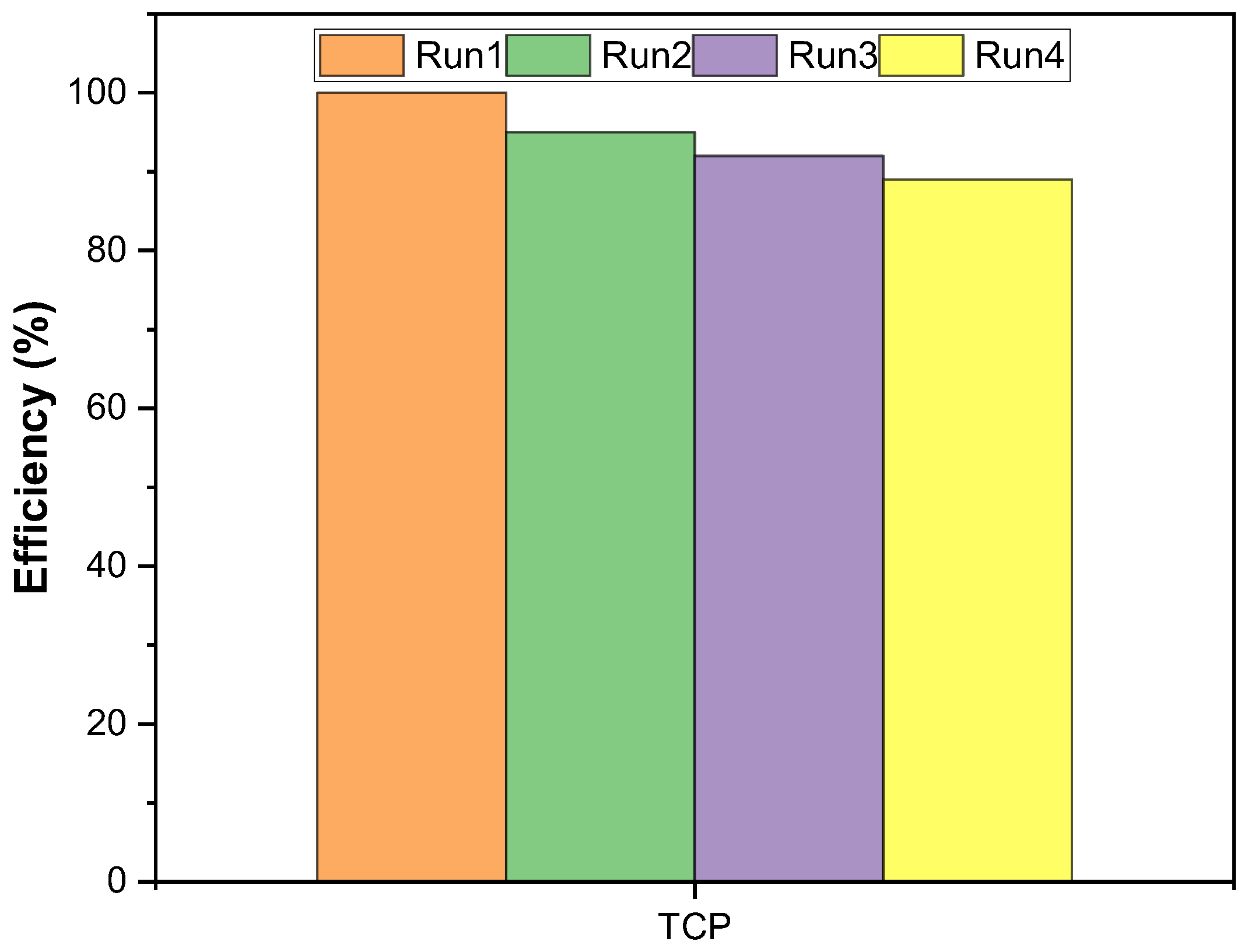Investigation of Calcium Phosphate Catalysts in Sodium Borohydride Methanolysis for Improved Hydrogen Production
Abstract
:1. Introduction
2. Results and Discussion
2.1. Catalyst Characterization
2.1.1. X-ray Diffraction Analysis
2.1.2. Surface Morphology Using SEM
2.2. Determination of the Catalytic Activity of the Prepared Catalysts
2.3. Impact of TCP Weight Variation on Rates of Hydrogen Generation
2.4. The Influence of Temperature on the Methanolysis Process of NaBH4 Catalyzed by TCP
- kB is Boltzmann’s constant (1.381 × 10−23 J/K);
- T is the absolute temperature in Kelvin (K);
- h is Planck’s constant (6.626 × 10−34 Js);
- R is the gas constant (8.314 J K−1 · mol−1).
2.5. HGR of the TCP Catalyst
3. Experiments
3.1. Materials and Methods
3.2. Synthesis of Calcium Phosphate Compounds
3.3. Hydrolysis Experiment
4. Conclusions
Author Contributions
Funding
Data Availability Statement
Conflicts of Interest
References
- Jacobson, M.Z. Review of Solutions to Global Warming, Air Pollution, and Energy Security. Energy Environ. Sci. 2009, 2, 148–173. [Google Scholar] [CrossRef]
- Davis, S.J.; Lewis, N.S.; Shaner, M.; Aggarwal, S.; Arent, D.; Azevedo, I.L.; Benson, S.M.; Bradley, T.; Brouwer, J.; Chiang, Y.-M.; et al. Net-Zero Emissions Energy Systems. Science 2018, 360, eaas9793. [Google Scholar] [CrossRef] [PubMed]
- Allen, M.R.; Frame, D.J.; Huntingford, C.; Jones, C.D.; Lowe, J.A.; Meinshausen, M.; Meinshausen, N. Warming Caused by Cumulative Carbon Emissions towards the Trillionth Tonne. Nature 2009, 458, 1163–1166. [Google Scholar] [CrossRef] [PubMed]
- Lelieveld, J.; Evans, J.S.; Fnais, M.; Giannadaki, D.; Pozzer, A. The Contribution of Outdoor Air Pollution Sources to Premature Mortality on a Global Scale. Nature 2015, 525, 367–371. [Google Scholar] [CrossRef] [PubMed]
- Jacobson, M.Z.; Delucchi, M.A.; Cameron, M.A.; Frew, B.A. Low-Cost Solution to the Grid Reliability Problem with 100% Penetration of Intermittent Wind, Water, and Solar for All Purposes. Proc. Natl. Acad. Sci. USA 2015, 112, 15060–15065. [Google Scholar] [CrossRef] [PubMed]
- Jaiswal, K.K.; Chowdhury, C.R.; Yadav, D.; Verma, R.; Dutta, S.; Jaiswal, K.S.; Sangmesh, B.; Karuppasamy, K.S.K. Renewable and Sustainable Clean Energy Development and Impact on Social, Economic, and Environmental Health. Energy Nexus 2022, 7, 100118. [Google Scholar] [CrossRef]
- Bal, J.-L.; Chabot, B. Les Énergies Renouvelables. État de l’art et Perspectives de Développement. Comptes Rendus L’académie Sci. Ser. IIA Earth Planet. Sci. 2001, 333, 827–834. [Google Scholar] [CrossRef]
- Archer, C.L.; Jacobson, M.Z. Evaluation of Global Wind Power. J. Geophys. Res. Atmos. 2005, 110, 485. [Google Scholar] [CrossRef]
- Frey, G.; Linke, D. Hydropower as Renewable and Sustainable Energy Sources Meeting Global Energy Challenges in a Reasonable Way. Energy Policy 2002, 30, 1261–1265. [Google Scholar] [CrossRef]
- Sun, S. Development of Hydropower and the Environmental Impacts of Hydroelectric Dam Construction in China. E3S Web Conf. 2023, 393, 01032. [Google Scholar] [CrossRef]
- Shortall, R.; Davidsdottir, B.; Axelsson, G. Geothermal Energy for Sustainable Development: A Review of Sustainability Impacts and Assessment Frameworks. Renew. Sustain. Energy Rev. 2015, 44, 391–406. [Google Scholar] [CrossRef]
- Abdalla, A.; Hossain, S.; Nisfindy, O.; Azad, A.; Dawood, M.; Azad, A. Hydrogen Production, Storage, Transportation and Key Challenges with Applications: A Review. Energy Convers. Manag. 2018, 165, 602–627. [Google Scholar] [CrossRef]
- Holladay, J.D.; Hu, J.; King, D.L.; Wang, Y. An Overview of Hydrogen Production Technologies. Catal. Today 2009, 139, 244–260. [Google Scholar] [CrossRef]
- Ni, M.; Leung, D.Y.C.; Leung, M.K.H.; Sumathy, K. An Overview of Hydrogen Production from Biomass. Fuel Process. Technol. 2006, 87, 461–472. [Google Scholar] [CrossRef]
- Janssen, H.; Bringmann, J.; Emonts, B.; Schroeder, V. Safety-Related Studies on Hydrogen Production in High-Pressure Electrolysers. Int. J. Hydrogen Energy 2004, 29, 759–770. [Google Scholar] [CrossRef]
- Bhandari, R.; Trudewind, C.A.; Zapp, P. Life Cycle Assessment of Hydrogen Production via Electrolysis—A Review. J. Clean. Prod. 2014, 85, 151–163. [Google Scholar] [CrossRef]
- Lu, Y.; Guo, L.; Zhang, X.; Yan, Q. Thermodynamic Modeling and Analysis of Biomass Gasification for Hydrogen Production in Supercritical Water. Chem. Eng. J. 2007, 131, 233–244. [Google Scholar] [CrossRef]
- Guo, Y.; Wang, S.Z.; Xu, D.H.; Gong, Y.M.; Ma, H.H.; Tang, X.Y. Review of Catalytic Supercritical Water Gasification for Hydrogen Production from Biomass. Renew. Sustain. Energy Rev. 2010, 14, 334–343. [Google Scholar] [CrossRef]
- Meda, U.S.; Bhat, N.; Pandey, A.; Subramanya, K.N.; Lourdu Antony Raj, M.A. Challenges Associated with Hydrogen Storage Systems Due to the Hydrogen Embrittlement of High Strength Steels. Int. J. Hydrogen Energy 2023, 48, 17894–17913. [Google Scholar] [CrossRef]
- Maupoix, C.; Houzelot, J.L.; Sciora, E.; Gaillard, G.; Charton, S.; Saviot, L.; Bernard, F. Experimental Investigation of the Grain Size Dependence of the Hydrolysis of LiH Powder. Powder Technol. 2011, 208, 318–323. [Google Scholar] [CrossRef]
- Khzouz, M.; Gkanas, E.I.; Girella, A.; Statheros, T.; Milanese, C. Sustainable Hydrogen Production via LiH Hydrolysis for Unmanned Air Vehicle (UAV) Applications. Int. J. Hydrogen Energy 2020, 45, 5384–5394. [Google Scholar] [CrossRef]
- Wu, X.; Xue, H.; Peng, Y.; Deng, J.; Xie, Z.; Zheng, J.; Li, X.; Li, S. Hydrogen Generation by Hydrolysis of MgH2-LiH Composite. Materials 2022, 15, 1593. [Google Scholar] [CrossRef] [PubMed]
- Huang, M.; Ouyang, L.; Wang, H.; Liu, J.; Zhu, M. Hydrogen Generation by Hydrolysis of MgH2 and Enhanced Kinetics Performance of Ammonium Chloride Introducing. Int. J. Hydrogen Energy 2015, 18, 6145–6150. [Google Scholar] [CrossRef]
- Xiao, Y.; Wu, C.; Wu, H.; Chen, Y. Hydrogen Generation by CaH2-Induced Hydrolysis of Mg17Al12 Hydride. Int. J. Hydrogen Energy 2011, 24, 15698–15703. [Google Scholar] [CrossRef]
- Chen, S.; Tang, Y.; Yu, H.; Bao, L.; Zhang, W.; DeLuca, L.T.; Shen, R.; Ye, Y. The Rapid H2 Release from AlH3 Dehydrogenation Forming Porous Layer in AlH3/Hydroxyl-Terminated Polybutadiene (HTPB) Fuels during Combustion. J. Hazard. Mater. 2019, 371, 53–61. [Google Scholar] [CrossRef] [PubMed]
- Thampan, T.; Atwater, T.; Cook, C.; Novoa, J.; Sutorik, A.C. Hydrogen Generation from Aluminum Hydride for Wearable Polymer Electrolyte Membrane Fuel Cells. Int. J. Hydrogen Energy 2016, 41, 9402–9409. [Google Scholar] [CrossRef]
- Chen, K.; Ouyang, L.; Wang, H.; Liu, J.; Shao, H.; Zhu, M. A High-Performance Hydrogen Generation System: Hydrolysis of LiBH4-Based Materials Catalyzed by Transition Metal Chlorides. Renew. Energy 2020, 156, 655–664. [Google Scholar] [CrossRef]
- Liu, Y.; Wang, X.; Liu, H.; Dong, Z.; Cao, G.; Yan, M. Hydrogen Generation from Mg–LiBH4 Hydrolysis Improved by AlCl3 Addition. Energy 2014, 68, 548–554. [Google Scholar] [CrossRef]
- Ouyang, L.; Chen, W.; Liu, J.; Felderhoff, M.; Wang, H.; Zhu, M. Enhancing the Regeneration Process of Consumed NaBH4 for Hydrogen Storage. Adv. Energy Mater. 2017, 7, 1700299. [Google Scholar] [CrossRef]
- Dudu, T.E.; Alpaslan, D.; Aktas, N. Hydrogen Production from Methanolysis of Sodium Borohydride by Non-Metal p(CO) Organo-Particles Synthesized from Castor Oil. J. Polym. Environ. 2022, 30, 4562–4570. [Google Scholar] [CrossRef]
- Brack, P.; Dann, S.E.; Wijayantha, K.G.U. Heterogeneous and Homogenous Catalysts for Hydrogen Generation by Hydrolysis of Aqueous Sodium Borohydride (NaBH4) Solutions. Energy Sci. Eng. 2015, 3, 174–188. [Google Scholar] [CrossRef]
- Inokawa, H.; Driss, H.; Trovela, F.; Miyaoka, H.; Ichikawa, T.; Kojima, Y.; Zaman, S.F.; Al-Zahrani, A.; Alhamed, Y.; Petrov, L. Catalytic Hydrolysis of Sodium Borohydride on Co Catalysts. Int. J. Energy Res. 2016, 40, 2078–2090. [Google Scholar] [CrossRef]
- Abdelhamid, H.N. A review on hydrogen generation from the hydrolysis of sodium borohydride. Int. J. Hydrogen Energy 2021, 46, 726–765. [Google Scholar] [CrossRef]
- Slamet, S.; Tristantini Budi, D.; Valentina, V.; Ibadurrohman, M. Photocatalytic Hydrogen Production from Glycerol–Water Mixture over Pt-N-TiO2. Int. J. Energy Res. 2013, 37, 1372–1381. [Google Scholar] [CrossRef]
- Ramachandran, P.V.; Hazra, D.; Raju, B.C.; Mereddy, V.R.; Bhattacharyya, A. Method of Controlled Alcoholysis and Regeneration of a Borohydride. U.S. Patent 7,601,797, 2009. [Google Scholar]
- Arzac, G.M.; Fernández, A. Hydrogen Production through Sodium Borohydride Ethanolysis. Int. J. Hydrogen Energy 2015, 40, 5326–5332. [Google Scholar] [CrossRef]
- Brown, H.C.; Mead, E.J.; Subba Rao, B.C. A Study of Solvents for Sodium Borohydride and the Effect of Solvent and the Metal Ion on Borohydride Reductions. J. Am. Chem. Soc. 1955, 77, 6209–6213. [Google Scholar] [CrossRef]
- Davis, R.E.; Gottbrath, J.A. Boron Hydrides. V. Methanolysis of Sodium Borohydride. J. Am. Chem. Soc. 1962, 84, 895–898. [Google Scholar] [CrossRef]
- Lo, C.F.; Karan, K.; Davis, B.R. Kinetic Studies of Reaction between Sodium Borohydride and Methanol, Water, and Their Mixtures. Ind. Eng. Chem. Res 2007, 46, 5478–5484. [Google Scholar] [CrossRef]
- Wu, Z.; Mao, X.; Zi, Q.; Zhang, R.; Dou, T.; Yip, A.C.K. Mechanism and Kinetics of Sodium Borohydride Hydrolysis over Crystalline Nickel and Nickel Boride and Amorphous Nickel–Boron Nanoparticles. J. Power Sources 2014, 268, 596–603. [Google Scholar] [CrossRef]
- Metin, Ö.; Özkar, S. Hydrogen Generation from the Hydrolysis of Ammonia-Borane and Sodium Borohydride Using Water-Soluble Polymer-Stabilized Cobalt(0) Nanoclusters Catalyst. Energy Fuels 2009, 23, 3517–3526. [Google Scholar] [CrossRef]
- Akbayrak, S.; Ozkar, S. Ruthenium(0) Nanoparticles Supported on Multiwalled Carbon Nanotube as Highly Active Catalyst for Hydrogen Generation from Ammonia-Borane. ACS Appl. Mater. Interfaces 2012, 4, 6302–6310. [Google Scholar] [CrossRef] [PubMed]
- Lo, C.-T.F.; Karan, K.; Davis, B.R. Kinetic Assessment of Catalysts for the Methanolysis of Sodium Borohydride for Hydrogen Generation. Ind. Eng. Chem. Res. 2009, 48, 5177–5184. [Google Scholar] [CrossRef]
- Chanburanasiri, N.; Ribeiro, A.M.; Rodrigues, A.E.; Arpornwichanop, A.; Laosiripojana, N.; Praserthdam, P.; Assabumrungrat, S. Hydrogen Production via Sorption Enhanced Steam Methane Reforming Process Using Ni/CaO Multifunctional Catalyst. Ind. Eng. Chem. Res. 2011, 50, 13662–13671. [Google Scholar] [CrossRef]
- Suda, S.; Morigasaki, N.; Iwase, Y.; Li, Z.P. Production of Sodium Borohydride by Using Dynamic Behaviors of Protide at the Extreme Surface of Magnesium Particles. J. Alloys Compd. 2005, 404–406, 643–647. [Google Scholar] [CrossRef]
- Nabid, M.R.; Bide, Y.; Kamali, B. Hydrogen Release from Sodium Borohydride by Fe2O3@nitrogen-Doped Carbon Core-Shell Nanosheets as Reasonable Heterogeneous Catalyst. Int. J. Hydrogen Energy 2019, 44, 25662–25670. [Google Scholar] [CrossRef]
- Yu, J.; Hai, Y.; Jaroniec, M. Photocatalytic Hydrogen Production over CuO-Modified Titania. J. Colloid Interface Sci. 2011, 357, 223–228. [Google Scholar] [CrossRef] [PubMed]
- Le Gars Santoni, B.; Niggli, L.; Dolder, S.; Loeffel, O.; Sblendorio, G.A.; Heuberger, R.; Maazouz, Y.; Stähli, C.; Döbelin, N.; Bowen, P.; et al. Effect of Minor Amounts of β-Calcium Pyrophosphate and Hydroxyapatite on the Physico-Chemical Properties and Osteoclastic Resorption of β-Tricalcium Phosphate Cylinders. Bioact. Mater. 2022, 10, 222–235. [Google Scholar] [CrossRef] [PubMed]
- Lyczko, N.; Nzihou, A.; Sharrok, P. Calcium Phosphate Sorbent for Environmental Application. Procedia Eng. 2014, 83, 423–431. [Google Scholar] [CrossRef]
- Suryawanshi, V.B.; Chaudhari, R.T. Growth and Characterization of Agar Gel Grown Brushite Crystals. Indian J. Mater. Sci. 2014, 2014, 189839. [Google Scholar] [CrossRef]
- Nguyen, N.K.; Leoni, M.; Maniglio, D.; Migliaresi, C. Hydroxyapatite Nanorods: Soft-Template Synthesis, Characterization and Preliminary in Vitro Tests. J. Biomater. Appl. 2013, 28, 49–61. [Google Scholar] [CrossRef]
- Granados-Correa, F.; Bonifacio-Martínez, J.; Serrano-Gómez, J. The ball milling effect on tribasic calcium phosphate and its chromium (vi) ion sorption properties. J. Chil. Chem. Soc. 2009, 54, 252–255. [Google Scholar] [CrossRef]
- Xidaki, D.; Agrafioti, P.; Diomatari, D.; Kaminari, A.; Tsalavoutas-Psarras, E.; Alexiou, P.; Psycharis, V.; Tsilibary, E.C.; Silvestros, S.; Sagnou, M. Synthesis of Hydroxyapatite, β-Tricalcium Phosphate and Biphasic Calcium Phosphate Particles to Act as Local Delivery Carriers of Curcumin: Loading, Release and In Vitro Studies. Materials 2018, 11, 595. [Google Scholar] [CrossRef] [PubMed]
- Patel, D.M.; Gujarati, V.P.; Sumesh, C.K.; Pataniya, P.M. Enhanced hydrolysis of NaBH4 using cobalt sulphide for hydrogen production. Inorg. Chem. Commun. 2024, 166, 112678. [Google Scholar] [CrossRef]
- Alshammari, M.; Alshammari, K.; Alhassan, S.; Alshammari, A.H.; Alotaibi, T.; Alotibi, S.; Ismael, A.; Taha, T.A.M. A High-Performance Cr2O3/CaCO3 Nanocomposite Catalyst for Rapid Hydrogen Generation from NaBH4. Nanomaterials 2024, 14, 333. [Google Scholar] [CrossRef] [PubMed]
- Holmes, J.M.; Beebe, R.A. Surface Areas by Gas Adsorption on Amorphous Calcium Phosphate and Crystalline Hydroxyapatite. Calc. Tis. Res. 1971, 7, 163–174. [Google Scholar] [CrossRef]
- Golovanova, O.A.; Golovchenko, K.K. Amino Acid Adsorption on Surfaces of Brushite and Hydroxylapatite. Russ. J. Phys. Chem. A 2019, 93, 2275–2283. [Google Scholar] [CrossRef]
- Kytsya, A.; Berezovets, V.; Verbovytskyy, Y.; Bazylyak, L.; Kordan, V.; Zavaliy, I.; Yartys, V.A. Bimetallic Ni-Co Nanoparticles as an Efficient Catalyst of Hydrogen Generation via Hydrolysis of. J. Alloys Compd. 2022, 908, 164484. [Google Scholar] [CrossRef]
- Prasad, D.; Patil, K.N.; Sandhya, N.; Chaitra, C.R.; Bhanushali, J.T.; Samal, A.K.; Keri, R.S.; Jadhav, A.H.; Nagaraja, B.M. Highly Efficient Hydrogen Production by Hydrolysis of NaBH4 Using Eminently Competent Recyclable Fe2O3 Decorated Oxidized MWCNTs Robust Catalyst. Appl. Surf. Sci. 2019, 489, 538–551. [Google Scholar] [CrossRef]
- Alshammari, M.; Alhassan, S.; Alshammari, K.; Alotaibi, T.; Taha, T.A.M.; Alshammari, A.H.; Ismael, A. Synthesis of CaCO3/Cu2O/GO Nanocomposite Catalysts for Hydrogen Production from NaBH4 Methanolysis. Catalysts 2023, 13, 1010. [Google Scholar] [CrossRef]
- Pornea, A.M.; Abebe, M.W.; Kim, H. Ternary NiCoP Urchin like 3D Nanostructure Supported on Nickel Foam as a Catalyst for Hydrogen Generation of Alkaline NaBH4. Chem. Phys. 2019, 516, 152–159. [Google Scholar] [CrossRef]
- Patil, K.N.; Prasad, D.; Bhanushali, J.T.; Kim, H.; Atar, A.B.; Nagaraja, B.M.; Jadhav, A.H. Sustainable Hydrogen Generation by Catalytic Hydrolysis of NaBH4 Using Tailored Nanostructured Urchin-like CuCo2O4 Spinel Catalyst. Catal. Lett. 2020, 150, 586–604. [Google Scholar] [CrossRef]
- Sahiner, N. Modified Multi-Wall Carbon Nanotubes as Metal Free Catalyst for Application in H2 Production from Methanolysis of NaBH4. J. Power Sources 2017, 366, 178–184. [Google Scholar] [CrossRef]
- Wang, T.; Jiang, T.; Zhang, H.; Zhao, Y. Advances in Catalysts for Hydrogen Production by Methanolysis of Sodium Borohydride. Int. J. Hydrogen Energy 2022, 47, 14589–14610. [Google Scholar] [CrossRef]
- Kaya, M.; Bekirogullari, M. Investigation of Hydrogen Production from Sodium Borohydride Methanolysis in the Presence of Al2O3/Spirulina Platensis Supported Co Catalyst. European J. Sci. Technol. 2019, 1, 69–76. [Google Scholar] [CrossRef]
- Zimmer, K.; Shoemaker, R.; Ruminski, R. Synthesis and Characterization of a Fluxional Re(I) Carbonyl Complex Fac-[Re(CO)3(Dpop′)Cl] with the Nominally Tri-Dentate Ligand Dipyrido(2,3-a:3′,2′-j)Phenazine (Dpop′). Inorganica Chim. Acta 2006, 359, 1478–1484. [Google Scholar] [CrossRef]









| Phase | Ca/P Molar Ratio | Crystal Structure | a (Å) | b (Å) | c (Å) | ß° | Unit Cell Volume (Å3) |
|---|---|---|---|---|---|---|---|
| Brushite CaHPO4·2H2O | 1 | Monoclinic | 5.82 | 15.22 | 6.27 | 116.41 | 497.43 |
| Tricalcium Phosphate Ca3(PO4)2 | 1.5 | Trigonal (hexagonal axes) | 10.39 | - | 37.22 | - | 3479.57 |
| Hydroxyapatite Ca10(PO4)6(OH)2 | 1.62 | Hexagonal | 9.41 | - | 6.89 | - | 528.03 |
| Catalyst | Activ. Energy (kJ mol−1) | HGR (mL g−1 min−1) | Ref. |
|---|---|---|---|
| Ni | - | 325 | [58] |
| Ni50Co50 | 26 | 1600 | [58] |
| Fe2O3@OMWCNTs | 15.92 | 405 | [59] |
| Cu1.7Ca0.3O/GO | - | 9809 | [60] |
| a-Fe2O3@N-C NSs | - | 637 | [46] |
| NiCoP/Ni | 38.3 | 3986 | [61] |
| CuCo2O4 | 22 | 1370 | [62] |
| MWCNTeCOOH | 20.1 | 8766 | [63] |
| Brushite | - | 6210 | This work |
| Hydroxyapatite | - | 12,437 | This work |
| TCP | 23.9 | 15,214 | This work |
Disclaimer/Publisher’s Note: The statements, opinions and data contained in all publications are solely those of the individual author(s) and contributor(s) and not of MDPI and/or the editor(s). MDPI and/or the editor(s) disclaim responsibility for any injury to people or property resulting from any ideas, methods, instructions or products referred to in the content. |
© 2024 by the authors. Licensee MDPI, Basel, Switzerland. This article is an open access article distributed under the terms and conditions of the Creative Commons Attribution (CC BY) license (https://creativecommons.org/licenses/by/4.0/).
Share and Cite
Alsowayigh, M.M.; Alsehli, A.H.; Alqahtani, F.; Abdulaziz, F.; Tounsi, M.; Alshaaer, M.; Alanazi, A. Investigation of Calcium Phosphate Catalysts in Sodium Borohydride Methanolysis for Improved Hydrogen Production. Catalysts 2024, 14, 512. https://doi.org/10.3390/catal14080512
Alsowayigh MM, Alsehli AH, Alqahtani F, Abdulaziz F, Tounsi M, Alshaaer M, Alanazi A. Investigation of Calcium Phosphate Catalysts in Sodium Borohydride Methanolysis for Improved Hydrogen Production. Catalysts. 2024; 14(8):512. https://doi.org/10.3390/catal14080512
Chicago/Turabian StyleAlsowayigh, Marwah M., Amal H. Alsehli, Fahad Alqahtani, Fahad Abdulaziz, Moncef Tounsi, Mazen Alshaaer, and Abdulaziz Alanazi. 2024. "Investigation of Calcium Phosphate Catalysts in Sodium Borohydride Methanolysis for Improved Hydrogen Production" Catalysts 14, no. 8: 512. https://doi.org/10.3390/catal14080512





